Nursing Leadership: Strategies to Combat Nurse Burnout in Practice
VerifiedAdded on 2022/10/07
|10
|2286
|35
Presentation
AI Summary
This presentation explores the critical issue of nurse burnout and its impact on patient safety and the healthcare workplace. The presentation begins with a background on nurse burnout, highlighting the stressors contributing to it, such as excessive workloads and critical patient care, and the resulting effects on patient safety. It then establishes the objective of developing leadership skills to address these issues, focusing on the importance of nurses' involvement in training and skill development. The presentation outlines a professional development session designed to equip nursing students with leadership skills. It delves into the objectives of developing leadership skills, including self-awareness, motivation, collaboration, and effective communication. The presentation emphasizes the importance of reflective practice and stress management techniques. The conclusion underscores the significance of nursing leadership in mitigating burnout and improving patient safety, recommending training and reflective practice for nursing students. The presentation also includes a list of relevant references.
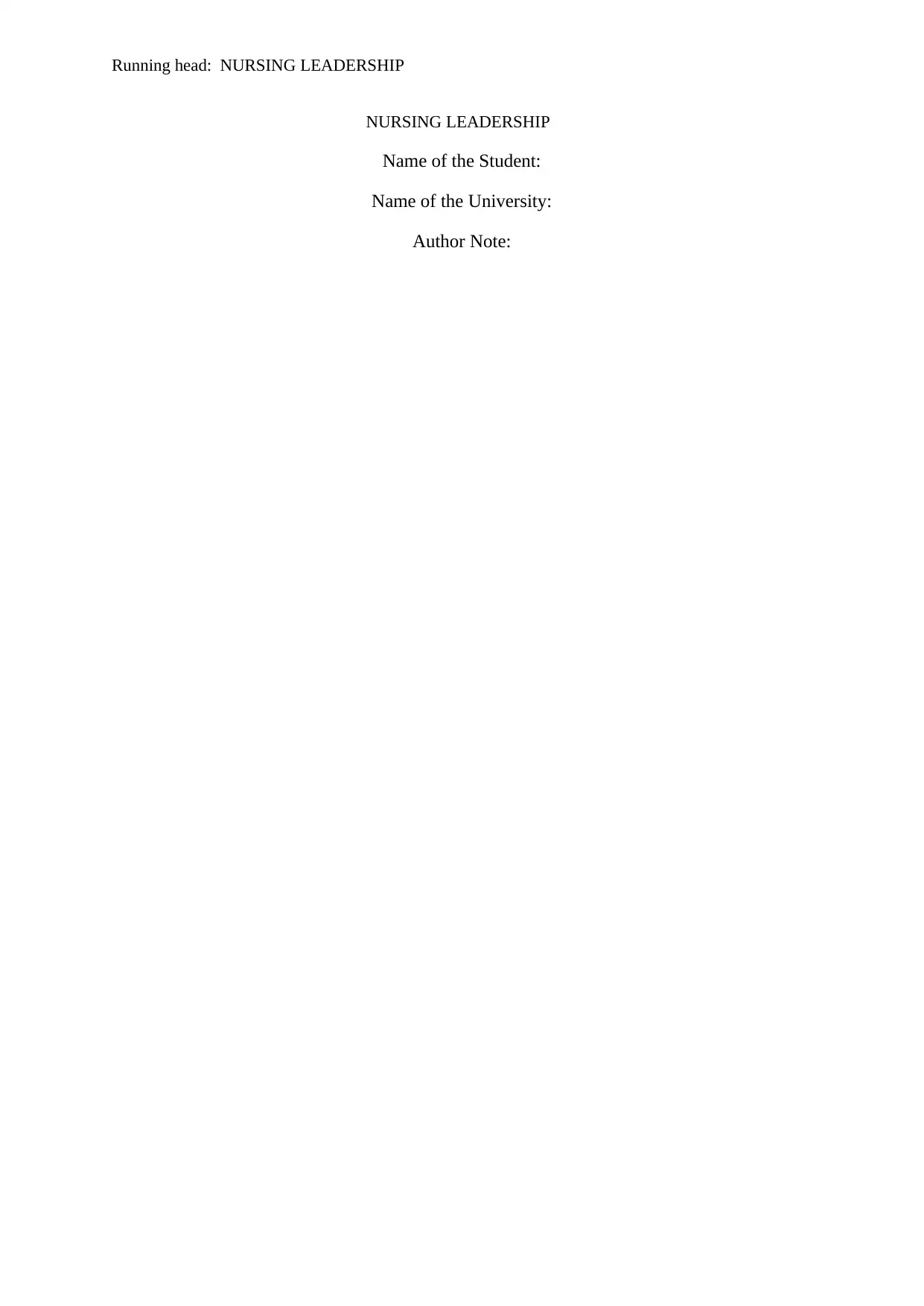
Running head: NURSING LEADERSHIP
NURSING LEADERSHIP
Name of the Student:
Name of the University:
Author Note:
NURSING LEADERSHIP
Name of the Student:
Name of the University:
Author Note:
Paraphrase This Document
Need a fresh take? Get an instant paraphrase of this document with our AI Paraphraser
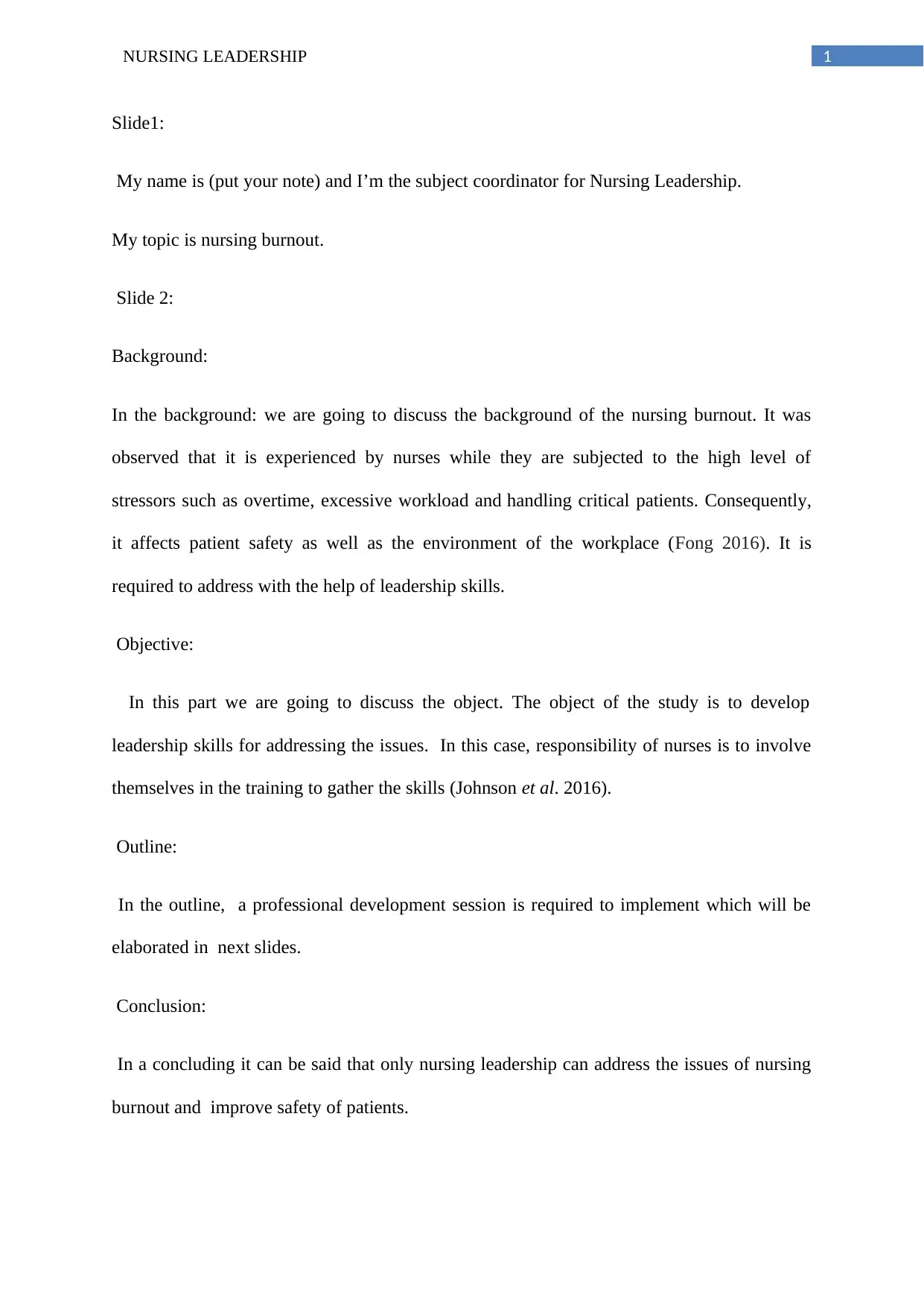
1NURSING LEADERSHIP
Slide1:
My name is (put your note) and I’m the subject coordinator for Nursing Leadership.
My topic is nursing burnout.
Slide 2:
Background:
In the background: we are going to discuss the background of the nursing burnout. It was
observed that it is experienced by nurses while they are subjected to the high level of
stressors such as overtime, excessive workload and handling critical patients. Consequently,
it affects patient safety as well as the environment of the workplace (Fong 2016). It is
required to address with the help of leadership skills.
Objective:
In this part we are going to discuss the object. The object of the study is to develop
leadership skills for addressing the issues. In this case, responsibility of nurses is to involve
themselves in the training to gather the skills (Johnson et al. 2016).
Outline:
In the outline, a professional development session is required to implement which will be
elaborated in next slides.
Conclusion:
In a concluding it can be said that only nursing leadership can address the issues of nursing
burnout and improve safety of patients.
Slide1:
My name is (put your note) and I’m the subject coordinator for Nursing Leadership.
My topic is nursing burnout.
Slide 2:
Background:
In the background: we are going to discuss the background of the nursing burnout. It was
observed that it is experienced by nurses while they are subjected to the high level of
stressors such as overtime, excessive workload and handling critical patients. Consequently,
it affects patient safety as well as the environment of the workplace (Fong 2016). It is
required to address with the help of leadership skills.
Objective:
In this part we are going to discuss the object. The object of the study is to develop
leadership skills for addressing the issues. In this case, responsibility of nurses is to involve
themselves in the training to gather the skills (Johnson et al. 2016).
Outline:
In the outline, a professional development session is required to implement which will be
elaborated in next slides.
Conclusion:
In a concluding it can be said that only nursing leadership can address the issues of nursing
burnout and improve safety of patients.
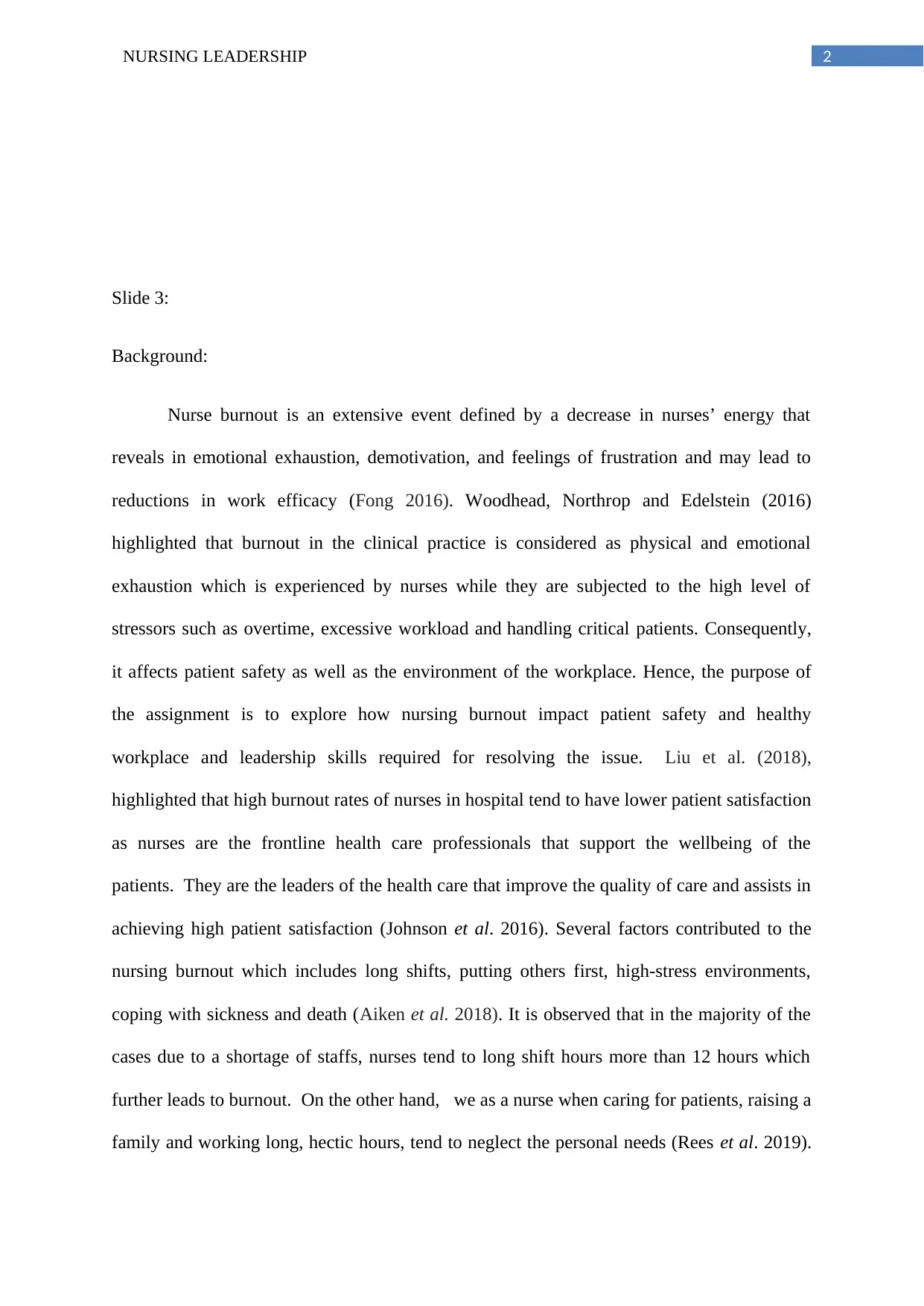
2NURSING LEADERSHIP
Slide 3:
Background:
Nurse burnout is an extensive event defined by a decrease in nurses’ energy that
reveals in emotional exhaustion, demotivation, and feelings of frustration and may lead to
reductions in work efficacy (Fong 2016). Woodhead, Northrop and Edelstein (2016)
highlighted that burnout in the clinical practice is considered as physical and emotional
exhaustion which is experienced by nurses while they are subjected to the high level of
stressors such as overtime, excessive workload and handling critical patients. Consequently,
it affects patient safety as well as the environment of the workplace. Hence, the purpose of
the assignment is to explore how nursing burnout impact patient safety and healthy
workplace and leadership skills required for resolving the issue. Liu et al. (2018),
highlighted that high burnout rates of nurses in hospital tend to have lower patient satisfaction
as nurses are the frontline health care professionals that support the wellbeing of the
patients. They are the leaders of the health care that improve the quality of care and assists in
achieving high patient satisfaction (Johnson et al. 2016). Several factors contributed to the
nursing burnout which includes long shifts, putting others first, high-stress environments,
coping with sickness and death (Aiken et al. 2018). It is observed that in the majority of the
cases due to a shortage of staffs, nurses tend to long shift hours more than 12 hours which
further leads to burnout. On the other hand, we as a nurse when caring for patients, raising a
family and working long, hectic hours, tend to neglect the personal needs (Rees et al. 2019).
Slide 3:
Background:
Nurse burnout is an extensive event defined by a decrease in nurses’ energy that
reveals in emotional exhaustion, demotivation, and feelings of frustration and may lead to
reductions in work efficacy (Fong 2016). Woodhead, Northrop and Edelstein (2016)
highlighted that burnout in the clinical practice is considered as physical and emotional
exhaustion which is experienced by nurses while they are subjected to the high level of
stressors such as overtime, excessive workload and handling critical patients. Consequently,
it affects patient safety as well as the environment of the workplace. Hence, the purpose of
the assignment is to explore how nursing burnout impact patient safety and healthy
workplace and leadership skills required for resolving the issue. Liu et al. (2018),
highlighted that high burnout rates of nurses in hospital tend to have lower patient satisfaction
as nurses are the frontline health care professionals that support the wellbeing of the
patients. They are the leaders of the health care that improve the quality of care and assists in
achieving high patient satisfaction (Johnson et al. 2016). Several factors contributed to the
nursing burnout which includes long shifts, putting others first, high-stress environments,
coping with sickness and death (Aiken et al. 2018). It is observed that in the majority of the
cases due to a shortage of staffs, nurses tend to long shift hours more than 12 hours which
further leads to burnout. On the other hand, we as a nurse when caring for patients, raising a
family and working long, hectic hours, tend to neglect the personal needs (Rees et al. 2019).
⊘ This is a preview!⊘
Do you want full access?
Subscribe today to unlock all pages.

Trusted by 1+ million students worldwide
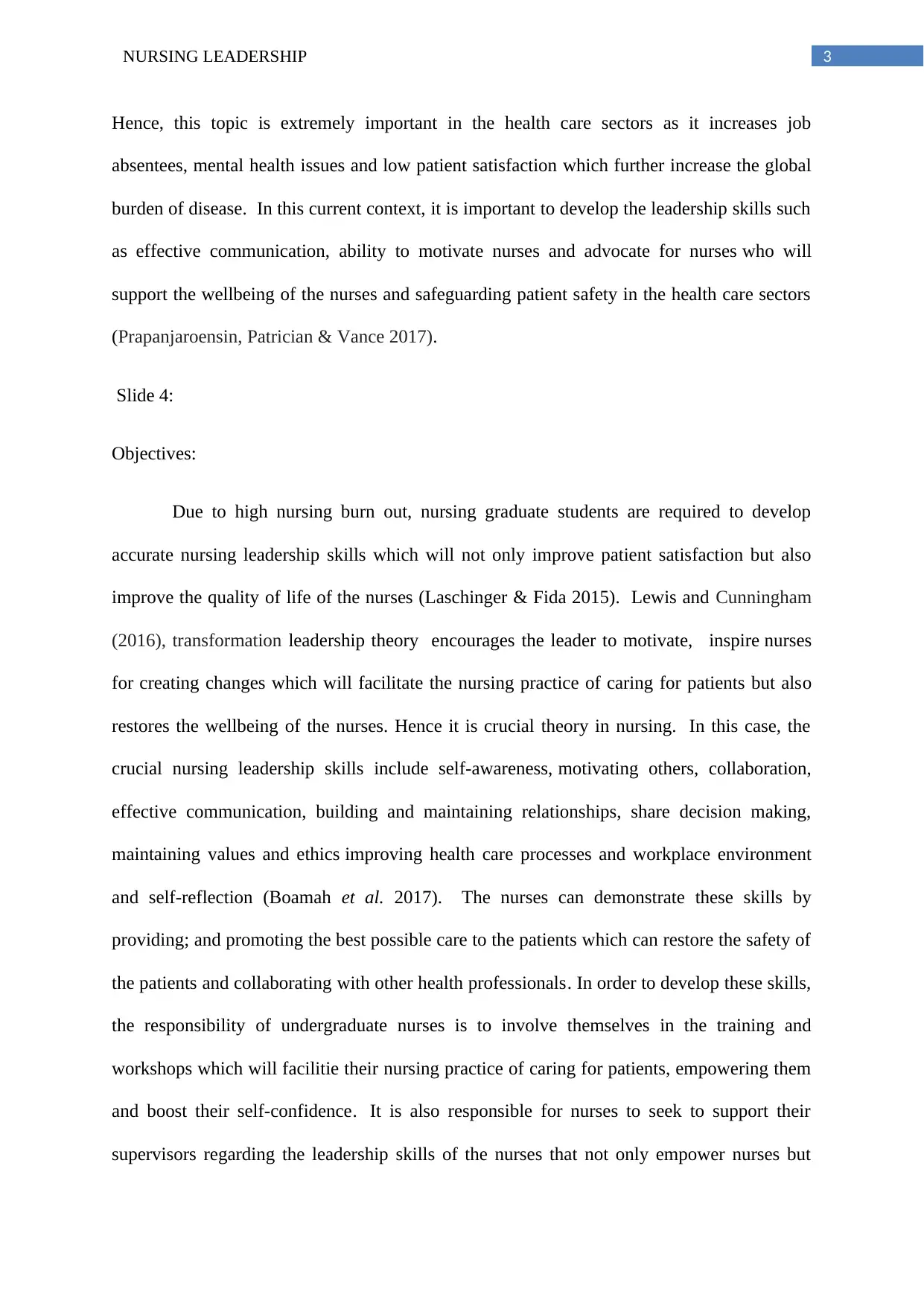
3NURSING LEADERSHIP
Hence, this topic is extremely important in the health care sectors as it increases job
absentees, mental health issues and low patient satisfaction which further increase the global
burden of disease. In this current context, it is important to develop the leadership skills such
as effective communication, ability to motivate nurses and advocate for nurses who will
support the wellbeing of the nurses and safeguarding patient safety in the health care sectors
(Prapanjaroensin, Patrician & Vance 2017).
Slide 4:
Objectives:
Due to high nursing burn out, nursing graduate students are required to develop
accurate nursing leadership skills which will not only improve patient satisfaction but also
improve the quality of life of the nurses (Laschinger & Fida 2015). Lewis and Cunningham
(2016), transformation leadership theory encourages the leader to motivate, inspire nurses
for creating changes which will facilitate the nursing practice of caring for patients but also
restores the wellbeing of the nurses. Hence it is crucial theory in nursing. In this case, the
crucial nursing leadership skills include self-awareness, motivating others, collaboration,
effective communication, building and maintaining relationships, share decision making,
maintaining values and ethics improving health care processes and workplace environment
and self-reflection (Boamah et al. 2017). The nurses can demonstrate these skills by
providing; and promoting the best possible care to the patients which can restore the safety of
the patients and collaborating with other health professionals. In order to develop these skills,
the responsibility of undergraduate nurses is to involve themselves in the training and
workshops which will facilitie their nursing practice of caring for patients, empowering them
and boost their self-confidence. It is also responsible for nurses to seek to support their
supervisors regarding the leadership skills of the nurses that not only empower nurses but
Hence, this topic is extremely important in the health care sectors as it increases job
absentees, mental health issues and low patient satisfaction which further increase the global
burden of disease. In this current context, it is important to develop the leadership skills such
as effective communication, ability to motivate nurses and advocate for nurses who will
support the wellbeing of the nurses and safeguarding patient safety in the health care sectors
(Prapanjaroensin, Patrician & Vance 2017).
Slide 4:
Objectives:
Due to high nursing burn out, nursing graduate students are required to develop
accurate nursing leadership skills which will not only improve patient satisfaction but also
improve the quality of life of the nurses (Laschinger & Fida 2015). Lewis and Cunningham
(2016), transformation leadership theory encourages the leader to motivate, inspire nurses
for creating changes which will facilitate the nursing practice of caring for patients but also
restores the wellbeing of the nurses. Hence it is crucial theory in nursing. In this case, the
crucial nursing leadership skills include self-awareness, motivating others, collaboration,
effective communication, building and maintaining relationships, share decision making,
maintaining values and ethics improving health care processes and workplace environment
and self-reflection (Boamah et al. 2017). The nurses can demonstrate these skills by
providing; and promoting the best possible care to the patients which can restore the safety of
the patients and collaborating with other health professionals. In order to develop these skills,
the responsibility of undergraduate nurses is to involve themselves in the training and
workshops which will facilitie their nursing practice of caring for patients, empowering them
and boost their self-confidence. It is also responsible for nurses to seek to support their
supervisors regarding the leadership skills of the nurses that not only empower nurses but
Paraphrase This Document
Need a fresh take? Get an instant paraphrase of this document with our AI Paraphraser
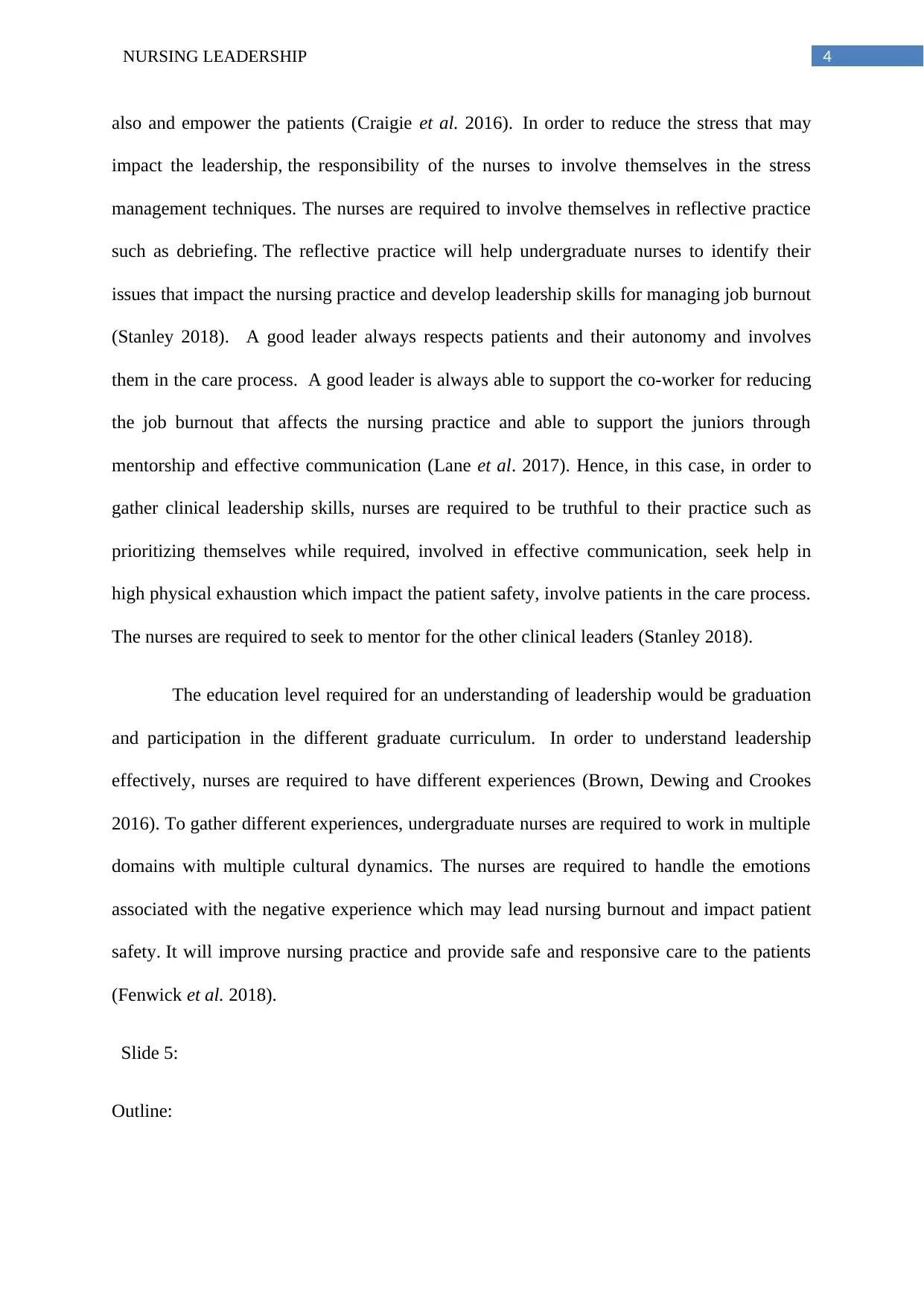
4NURSING LEADERSHIP
also and empower the patients (Craigie et al. 2016). In order to reduce the stress that may
impact the leadership, the responsibility of the nurses to involve themselves in the stress
management techniques. The nurses are required to involve themselves in reflective practice
such as debriefing. The reflective practice will help undergraduate nurses to identify their
issues that impact the nursing practice and develop leadership skills for managing job burnout
(Stanley 2018). A good leader always respects patients and their autonomy and involves
them in the care process. A good leader is always able to support the co-worker for reducing
the job burnout that affects the nursing practice and able to support the juniors through
mentorship and effective communication (Lane et al. 2017). Hence, in this case, in order to
gather clinical leadership skills, nurses are required to be truthful to their practice such as
prioritizing themselves while required, involved in effective communication, seek help in
high physical exhaustion which impact the patient safety, involve patients in the care process.
The nurses are required to seek to mentor for the other clinical leaders (Stanley 2018).
The education level required for an understanding of leadership would be graduation
and participation in the different graduate curriculum. In order to understand leadership
effectively, nurses are required to have different experiences (Brown, Dewing and Crookes
2016). To gather different experiences, undergraduate nurses are required to work in multiple
domains with multiple cultural dynamics. The nurses are required to handle the emotions
associated with the negative experience which may lead nursing burnout and impact patient
safety. It will improve nursing practice and provide safe and responsive care to the patients
(Fenwick et al. 2018).
Slide 5:
Outline:
also and empower the patients (Craigie et al. 2016). In order to reduce the stress that may
impact the leadership, the responsibility of the nurses to involve themselves in the stress
management techniques. The nurses are required to involve themselves in reflective practice
such as debriefing. The reflective practice will help undergraduate nurses to identify their
issues that impact the nursing practice and develop leadership skills for managing job burnout
(Stanley 2018). A good leader always respects patients and their autonomy and involves
them in the care process. A good leader is always able to support the co-worker for reducing
the job burnout that affects the nursing practice and able to support the juniors through
mentorship and effective communication (Lane et al. 2017). Hence, in this case, in order to
gather clinical leadership skills, nurses are required to be truthful to their practice such as
prioritizing themselves while required, involved in effective communication, seek help in
high physical exhaustion which impact the patient safety, involve patients in the care process.
The nurses are required to seek to mentor for the other clinical leaders (Stanley 2018).
The education level required for an understanding of leadership would be graduation
and participation in the different graduate curriculum. In order to understand leadership
effectively, nurses are required to have different experiences (Brown, Dewing and Crookes
2016). To gather different experiences, undergraduate nurses are required to work in multiple
domains with multiple cultural dynamics. The nurses are required to handle the emotions
associated with the negative experience which may lead nursing burnout and impact patient
safety. It will improve nursing practice and provide safe and responsive care to the patients
(Fenwick et al. 2018).
Slide 5:
Outline:
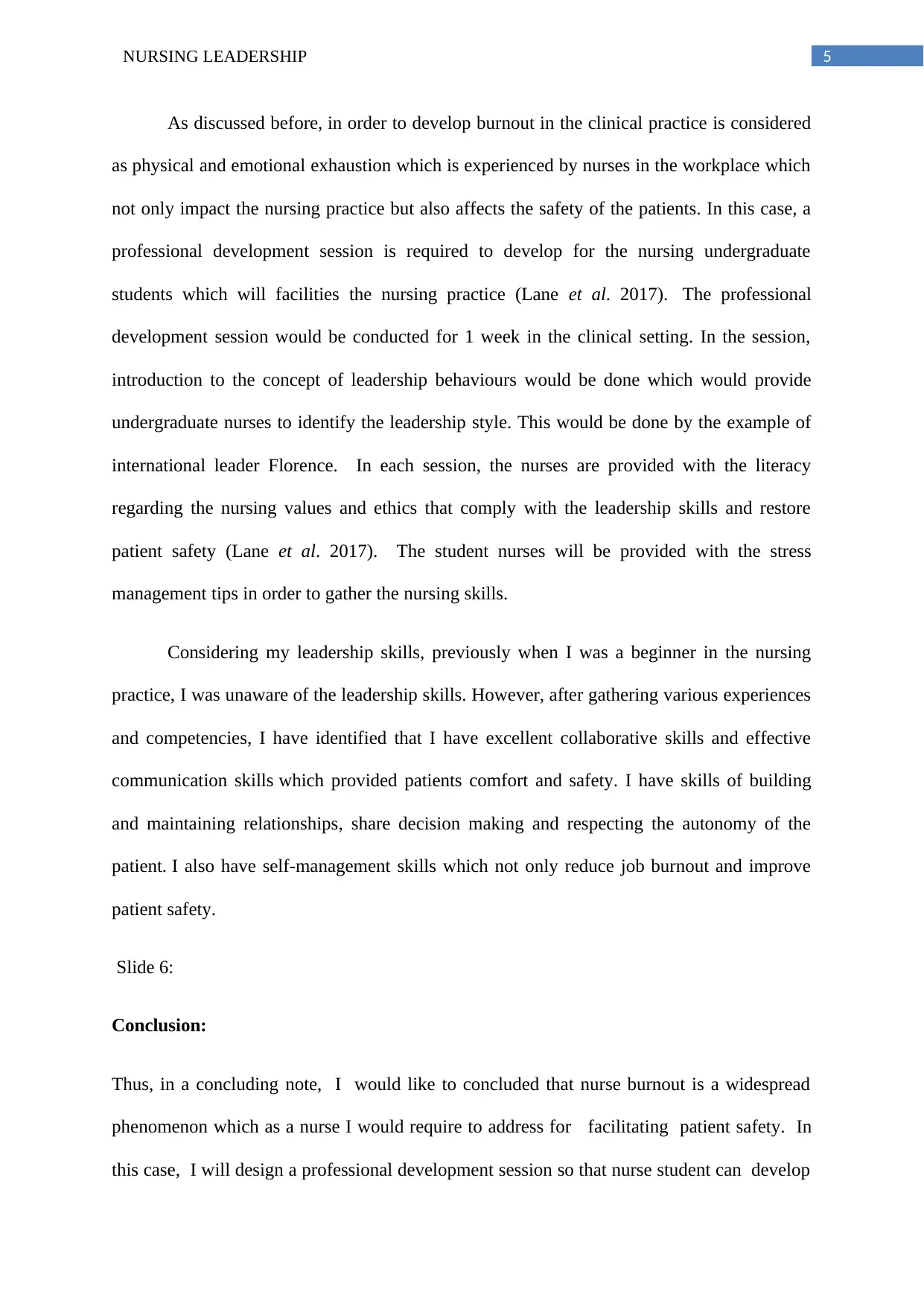
5NURSING LEADERSHIP
As discussed before, in order to develop burnout in the clinical practice is considered
as physical and emotional exhaustion which is experienced by nurses in the workplace which
not only impact the nursing practice but also affects the safety of the patients. In this case, a
professional development session is required to develop for the nursing undergraduate
students which will facilities the nursing practice (Lane et al. 2017). The professional
development session would be conducted for 1 week in the clinical setting. In the session,
introduction to the concept of leadership behaviours would be done which would provide
undergraduate nurses to identify the leadership style. This would be done by the example of
international leader Florence. In each session, the nurses are provided with the literacy
regarding the nursing values and ethics that comply with the leadership skills and restore
patient safety (Lane et al. 2017). The student nurses will be provided with the stress
management tips in order to gather the nursing skills.
Considering my leadership skills, previously when I was a beginner in the nursing
practice, I was unaware of the leadership skills. However, after gathering various experiences
and competencies, I have identified that I have excellent collaborative skills and effective
communication skills which provided patients comfort and safety. I have skills of building
and maintaining relationships, share decision making and respecting the autonomy of the
patient. I also have self-management skills which not only reduce job burnout and improve
patient safety.
Slide 6:
Conclusion:
Thus, in a concluding note, I would like to concluded that nurse burnout is a widespread
phenomenon which as a nurse I would require to address for facilitating patient safety. In
this case, I will design a professional development session so that nurse student can develop
As discussed before, in order to develop burnout in the clinical practice is considered
as physical and emotional exhaustion which is experienced by nurses in the workplace which
not only impact the nursing practice but also affects the safety of the patients. In this case, a
professional development session is required to develop for the nursing undergraduate
students which will facilities the nursing practice (Lane et al. 2017). The professional
development session would be conducted for 1 week in the clinical setting. In the session,
introduction to the concept of leadership behaviours would be done which would provide
undergraduate nurses to identify the leadership style. This would be done by the example of
international leader Florence. In each session, the nurses are provided with the literacy
regarding the nursing values and ethics that comply with the leadership skills and restore
patient safety (Lane et al. 2017). The student nurses will be provided with the stress
management tips in order to gather the nursing skills.
Considering my leadership skills, previously when I was a beginner in the nursing
practice, I was unaware of the leadership skills. However, after gathering various experiences
and competencies, I have identified that I have excellent collaborative skills and effective
communication skills which provided patients comfort and safety. I have skills of building
and maintaining relationships, share decision making and respecting the autonomy of the
patient. I also have self-management skills which not only reduce job burnout and improve
patient safety.
Slide 6:
Conclusion:
Thus, in a concluding note, I would like to concluded that nurse burnout is a widespread
phenomenon which as a nurse I would require to address for facilitating patient safety. In
this case, I will design a professional development session so that nurse student can develop
⊘ This is a preview!⊘
Do you want full access?
Subscribe today to unlock all pages.

Trusted by 1+ million students worldwide
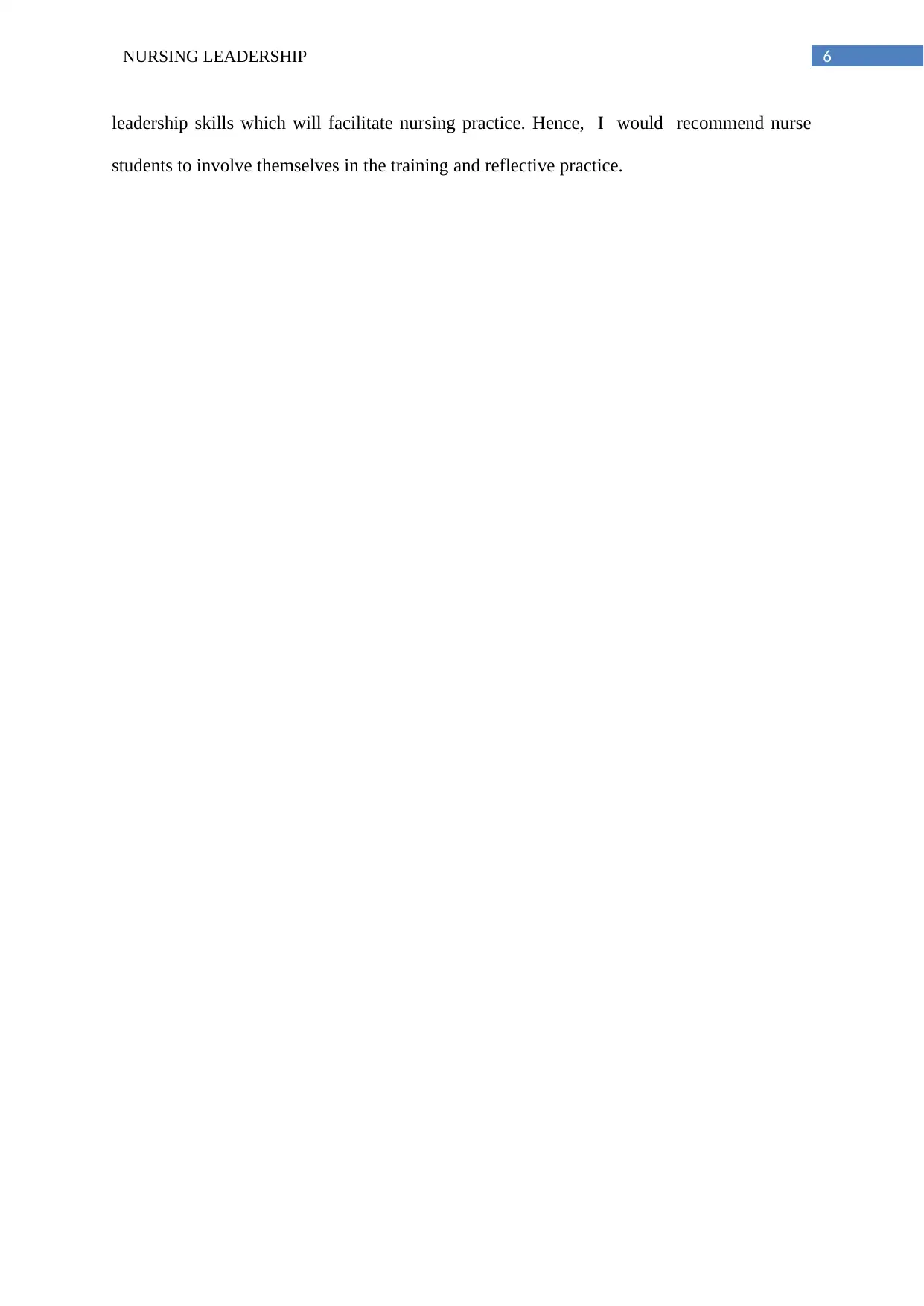
6NURSING LEADERSHIP
leadership skills which will facilitate nursing practice. Hence, I would recommend nurse
students to involve themselves in the training and reflective practice.
leadership skills which will facilitate nursing practice. Hence, I would recommend nurse
students to involve themselves in the training and reflective practice.
Paraphrase This Document
Need a fresh take? Get an instant paraphrase of this document with our AI Paraphraser
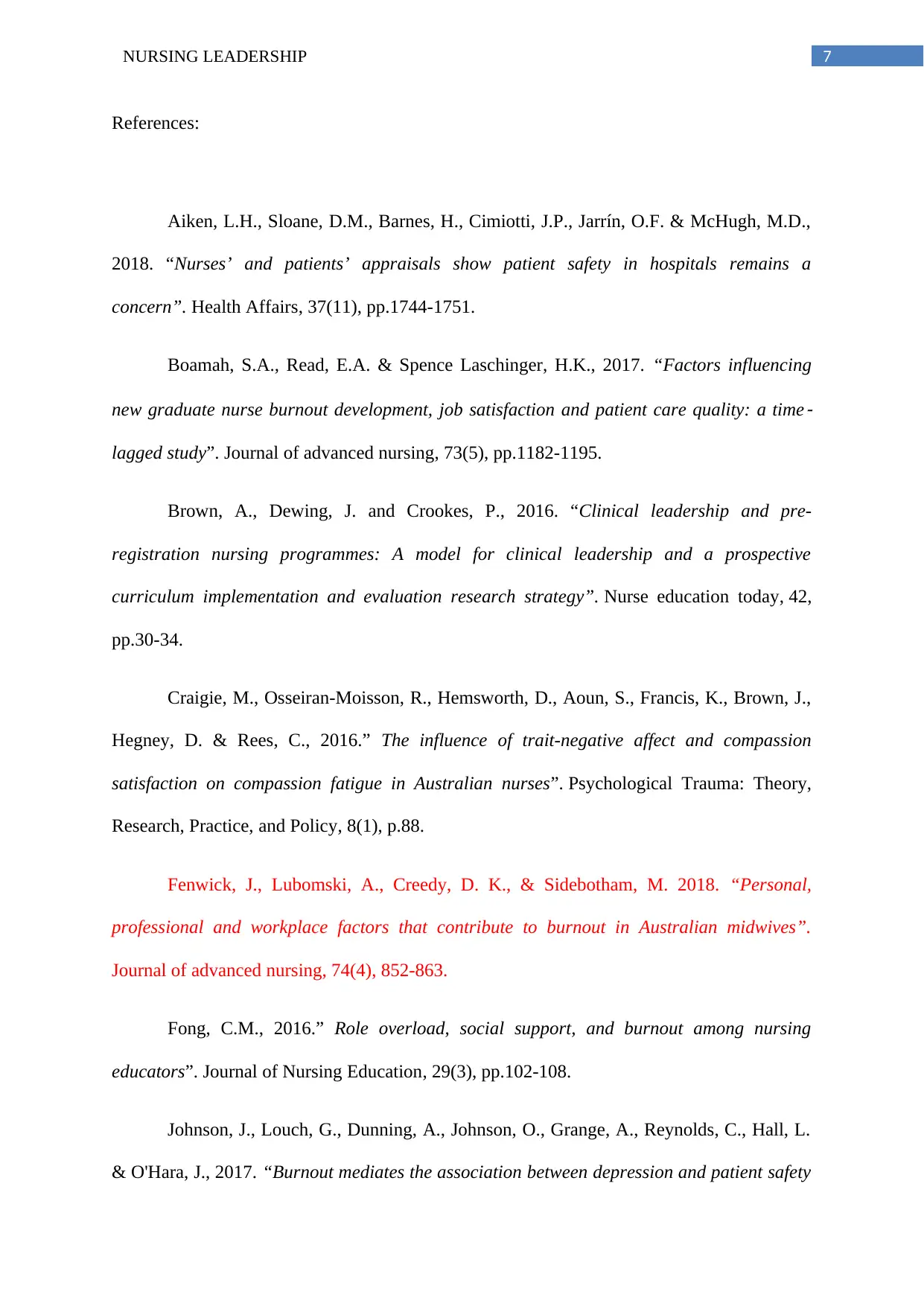
7NURSING LEADERSHIP
References:
Aiken, L.H., Sloane, D.M., Barnes, H., Cimiotti, J.P., Jarrín, O.F. & McHugh, M.D.,
2018. “Nurses’ and patients’ appraisals show patient safety in hospitals remains a
concern”. Health Affairs, 37(11), pp.1744-1751.
Boamah, S.A., Read, E.A. & Spence Laschinger, H.K., 2017. “Factors influencing
new graduate nurse burnout development, job satisfaction and patient care quality: a time
‐
lagged study”. Journal of advanced nursing, 73(5), pp.1182-1195.
Brown, A., Dewing, J. and Crookes, P., 2016. “Clinical leadership and pre-
registration nursing programmes: A model for clinical leadership and a prospective
curriculum implementation and evaluation research strategy”. Nurse education today, 42,
pp.30-34.
Craigie, M., Osseiran-Moisson, R., Hemsworth, D., Aoun, S., Francis, K., Brown, J.,
Hegney, D. & Rees, C., 2016.” The influence of trait-negative affect and compassion
satisfaction on compassion fatigue in Australian nurses”. Psychological Trauma: Theory,
Research, Practice, and Policy, 8(1), p.88.
Fenwick, J., Lubomski, A., Creedy, D. K., & Sidebotham, M. 2018. “Personal,
professional and workplace factors that contribute to burnout in Australian midwives”.
Journal of advanced nursing, 74(4), 852-863.
Fong, C.M., 2016.” Role overload, social support, and burnout among nursing
educators”. Journal of Nursing Education, 29(3), pp.102-108.
Johnson, J., Louch, G., Dunning, A., Johnson, O., Grange, A., Reynolds, C., Hall, L.
& O'Hara, J., 2017. “Burnout mediates the association between depression and patient safety
References:
Aiken, L.H., Sloane, D.M., Barnes, H., Cimiotti, J.P., Jarrín, O.F. & McHugh, M.D.,
2018. “Nurses’ and patients’ appraisals show patient safety in hospitals remains a
concern”. Health Affairs, 37(11), pp.1744-1751.
Boamah, S.A., Read, E.A. & Spence Laschinger, H.K., 2017. “Factors influencing
new graduate nurse burnout development, job satisfaction and patient care quality: a time
‐
lagged study”. Journal of advanced nursing, 73(5), pp.1182-1195.
Brown, A., Dewing, J. and Crookes, P., 2016. “Clinical leadership and pre-
registration nursing programmes: A model for clinical leadership and a prospective
curriculum implementation and evaluation research strategy”. Nurse education today, 42,
pp.30-34.
Craigie, M., Osseiran-Moisson, R., Hemsworth, D., Aoun, S., Francis, K., Brown, J.,
Hegney, D. & Rees, C., 2016.” The influence of trait-negative affect and compassion
satisfaction on compassion fatigue in Australian nurses”. Psychological Trauma: Theory,
Research, Practice, and Policy, 8(1), p.88.
Fenwick, J., Lubomski, A., Creedy, D. K., & Sidebotham, M. 2018. “Personal,
professional and workplace factors that contribute to burnout in Australian midwives”.
Journal of advanced nursing, 74(4), 852-863.
Fong, C.M., 2016.” Role overload, social support, and burnout among nursing
educators”. Journal of Nursing Education, 29(3), pp.102-108.
Johnson, J., Louch, G., Dunning, A., Johnson, O., Grange, A., Reynolds, C., Hall, L.
& O'Hara, J., 2017. “Burnout mediates the association between depression and patient safety
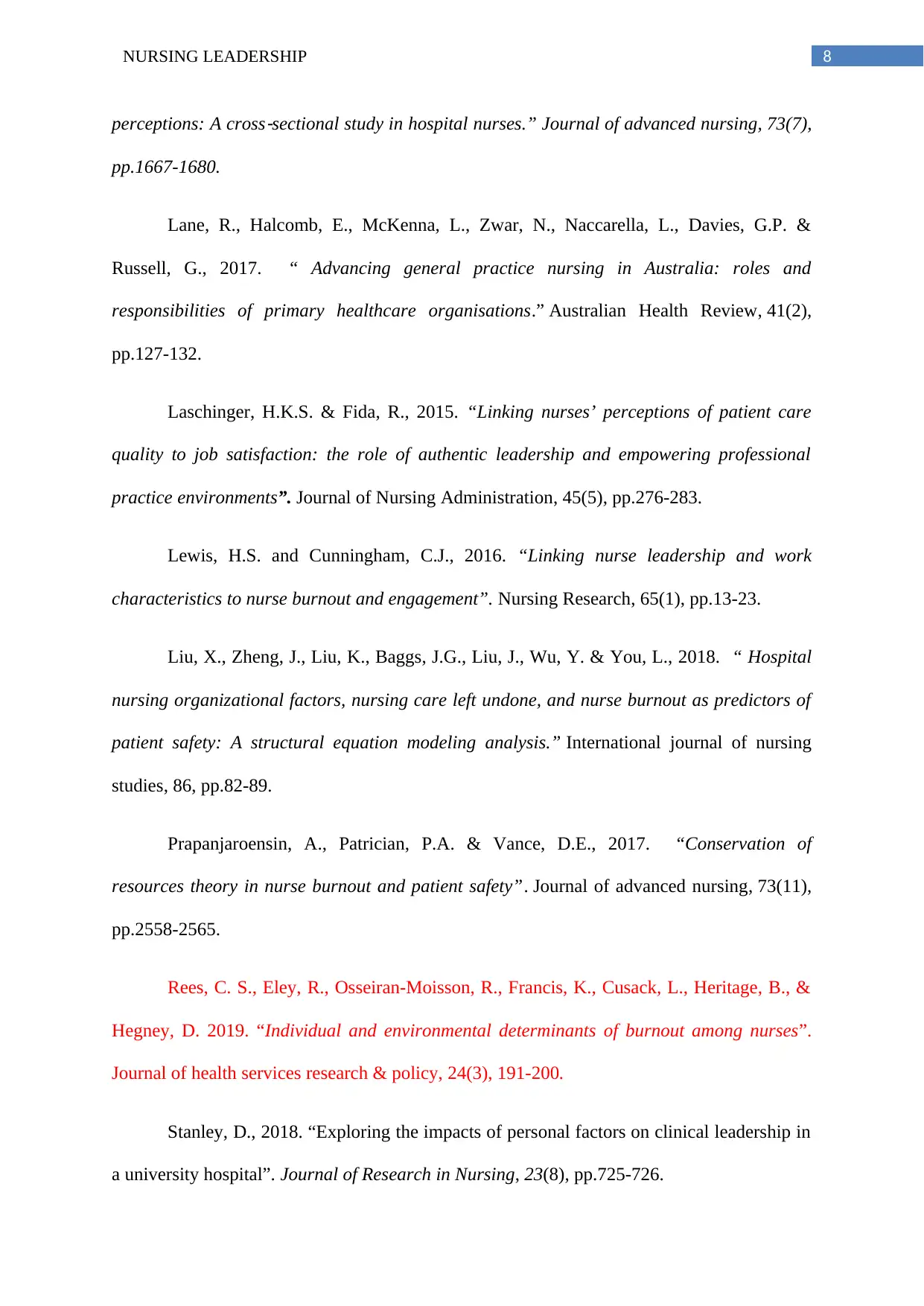
8NURSING LEADERSHIP
perceptions: A cross
‐sectional study in hospital nurses.” Journal of advanced nursing, 73(7),
pp.1667-1680.
Lane, R., Halcomb, E., McKenna, L., Zwar, N., Naccarella, L., Davies, G.P. &
Russell, G., 2017. “ Advancing general practice nursing in Australia: roles and
responsibilities of primary healthcare organisations.” Australian Health Review, 41(2),
pp.127-132.
Laschinger, H.K.S. & Fida, R., 2015. “Linking nurses’ perceptions of patient care
quality to job satisfaction: the role of authentic leadership and empowering professional
practice environments”. Journal of Nursing Administration, 45(5), pp.276-283.
Lewis, H.S. and Cunningham, C.J., 2016. “Linking nurse leadership and work
characteristics to nurse burnout and engagement”. Nursing Research, 65(1), pp.13-23.
Liu, X., Zheng, J., Liu, K., Baggs, J.G., Liu, J., Wu, Y. & You, L., 2018. “ Hospital
nursing organizational factors, nursing care left undone, and nurse burnout as predictors of
patient safety: A structural equation modeling analysis.” International journal of nursing
studies, 86, pp.82-89.
Prapanjaroensin, A., Patrician, P.A. & Vance, D.E., 2017. “Conservation of
resources theory in nurse burnout and patient safety”. Journal of advanced nursing, 73(11),
pp.2558-2565.
Rees, C. S., Eley, R., Osseiran-Moisson, R., Francis, K., Cusack, L., Heritage, B., &
Hegney, D. 2019. “Individual and environmental determinants of burnout among nurses”.
Journal of health services research & policy, 24(3), 191-200.
Stanley, D., 2018. “Exploring the impacts of personal factors on clinical leadership in
a university hospital”. Journal of Research in Nursing, 23(8), pp.725-726.
perceptions: A cross
‐sectional study in hospital nurses.” Journal of advanced nursing, 73(7),
pp.1667-1680.
Lane, R., Halcomb, E., McKenna, L., Zwar, N., Naccarella, L., Davies, G.P. &
Russell, G., 2017. “ Advancing general practice nursing in Australia: roles and
responsibilities of primary healthcare organisations.” Australian Health Review, 41(2),
pp.127-132.
Laschinger, H.K.S. & Fida, R., 2015. “Linking nurses’ perceptions of patient care
quality to job satisfaction: the role of authentic leadership and empowering professional
practice environments”. Journal of Nursing Administration, 45(5), pp.276-283.
Lewis, H.S. and Cunningham, C.J., 2016. “Linking nurse leadership and work
characteristics to nurse burnout and engagement”. Nursing Research, 65(1), pp.13-23.
Liu, X., Zheng, J., Liu, K., Baggs, J.G., Liu, J., Wu, Y. & You, L., 2018. “ Hospital
nursing organizational factors, nursing care left undone, and nurse burnout as predictors of
patient safety: A structural equation modeling analysis.” International journal of nursing
studies, 86, pp.82-89.
Prapanjaroensin, A., Patrician, P.A. & Vance, D.E., 2017. “Conservation of
resources theory in nurse burnout and patient safety”. Journal of advanced nursing, 73(11),
pp.2558-2565.
Rees, C. S., Eley, R., Osseiran-Moisson, R., Francis, K., Cusack, L., Heritage, B., &
Hegney, D. 2019. “Individual and environmental determinants of burnout among nurses”.
Journal of health services research & policy, 24(3), 191-200.
Stanley, D., 2018. “Exploring the impacts of personal factors on clinical leadership in
a university hospital”. Journal of Research in Nursing, 23(8), pp.725-726.
⊘ This is a preview!⊘
Do you want full access?
Subscribe today to unlock all pages.

Trusted by 1+ million students worldwide
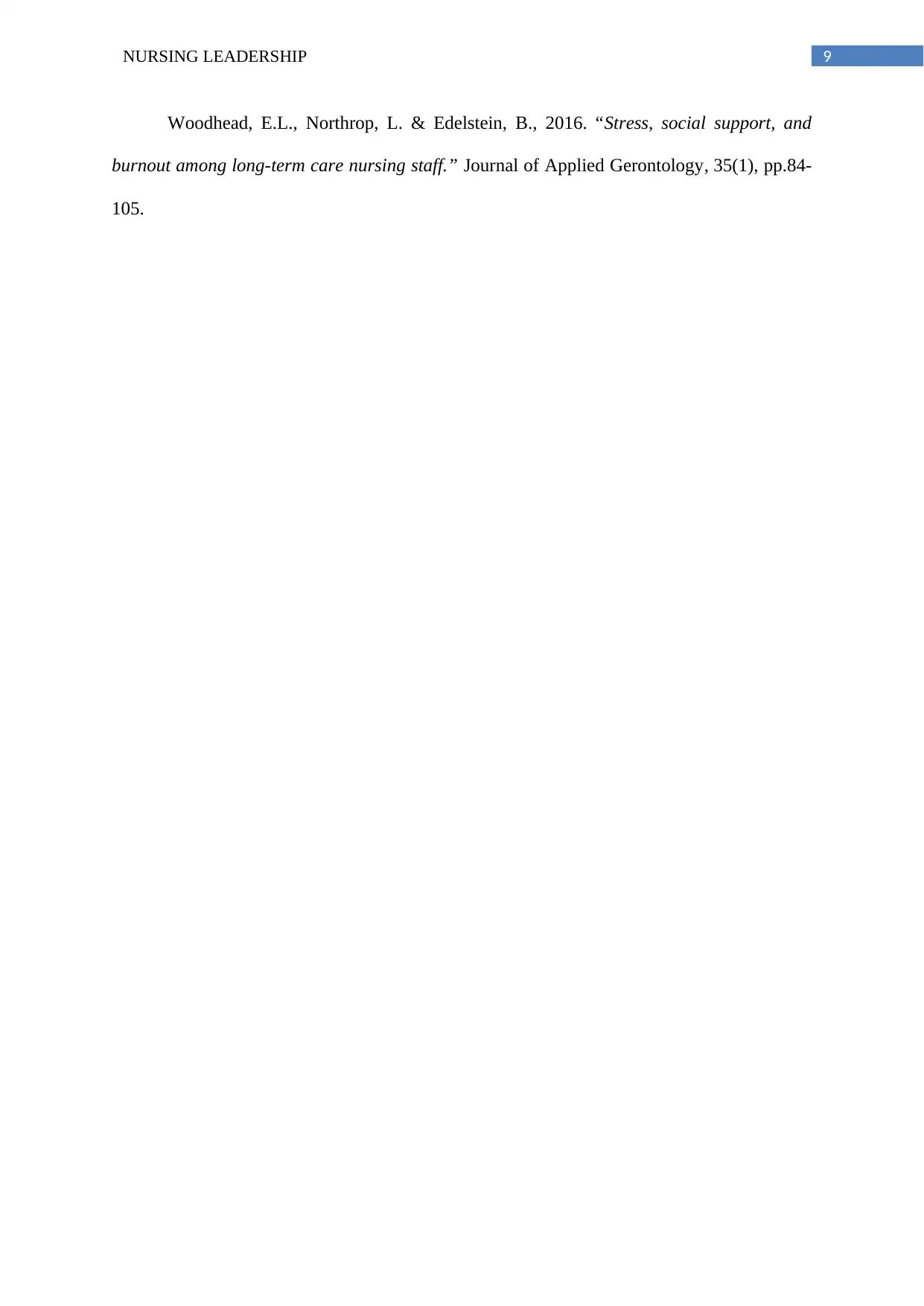
9NURSING LEADERSHIP
Woodhead, E.L., Northrop, L. & Edelstein, B., 2016. “Stress, social support, and
burnout among long-term care nursing staff.” Journal of Applied Gerontology, 35(1), pp.84-
105.
Woodhead, E.L., Northrop, L. & Edelstein, B., 2016. “Stress, social support, and
burnout among long-term care nursing staff.” Journal of Applied Gerontology, 35(1), pp.84-
105.
1 out of 10
Related Documents
Your All-in-One AI-Powered Toolkit for Academic Success.
+13062052269
info@desklib.com
Available 24*7 on WhatsApp / Email
![[object Object]](/_next/static/media/star-bottom.7253800d.svg)
Unlock your academic potential
Copyright © 2020–2025 A2Z Services. All Rights Reserved. Developed and managed by ZUCOL.





